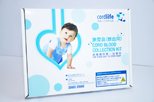How is Cord Blood Collected, Processed and Stored?
Stem cell isolation is a critical step in cord blood banking. It affects the number of stem cells that can be harvested or recovered from the cord blood. Cell recovery rates are critical because a higher number of stem cells could enhance the success of the transplant or treatment. That's why Cordlife has invested in the Sepax®2 automated stem cell processing technology, a safe, sterile and fully automated cord blood processing technology – so you get more stem cells for maximum transplant success^.
Step 1
After the baby is born, the umbilical cord will be clamped and within minutes, the obstetrician or caregiver will drain the cord blood into a sterile double-wrapped single-use blood bag. Your Cordlife Cord Blood Collection Kit contains all the necessary material to complete the collection of cord blood.

Step 2
Prior to cord blood processing, the identity of the cord blood collected is verified by our laboratory technologist to ensure that the unit belongs to the right client. After the identity verification step, the sample is transferred to the biohazard safety cabinet and a small amount of cord blood is extracted for testing.

Step 3
The laboratory technologist connects the blood bag and the single-use processing kit to our fully automated processing system, Sepax®2.

Step 4
Sepax®2 will then embark on a fully automated processing step to isolate stem cells contained in the cord blood from other unneeded components such as red blood cells and plasma. During this step, all the stem cells are automatically transferred into a connecting multi-compartment cryobag.

Step 5
Upon the completion of the processing step, the multi-compartment cryobag is detached from Sepax®2 and is placed into Smart Max, an automated mixing and cooling device that allows controlled and consistent preparation of stem cells for cryopreservation. During the addition of cryoprotectant solution, the Smart Max constantly mixes the buffy-coat to ensure homogeneous injection while keeping the cryobag at a constant and pre-defined temperature.

Step 6
Once the cryoprotectant solution has been added, stem cells are frozen gradually in controlled-rate freezer to preserve the viability of stem cells.

Step 7
The cryobag is transferred to MVE vapour-phase liquid nitrogen storage system for long term cryopreservation at -190°C.

^Reference
1.Rubinstein, P. (2009) Cord blood banking for clinical transplantation. Bone Marrow Transplantation. 44. pp. 635-642





Follow Us